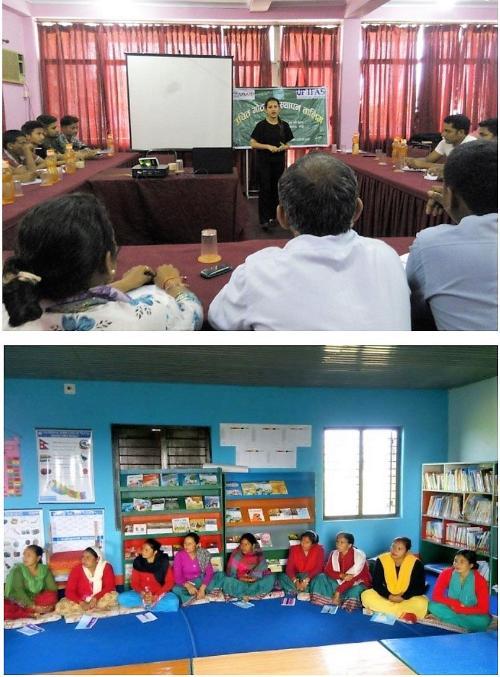Project in Nepal
Improving Dairy Animal Productivity and Income of Dairy Farmers through Effective Control of Mastitis Disease
Timeframe: October 2016 - March 2018
Funding: USAID
Principal investigator (PI) and lead institution
Keshav Prasad Sah, Heifer Project International Nepal
Co-PI and Collaborator Institutions
- Vijay Chandra Jha, Department of Livestock Services
- Bishwas Sharma, Himalayan College of Agricultural Science and Technology
Video
Results
Sah, K., Karki, P., Shrestha, R.D., Sigdel, A., Adesogan, A.T., and Dahl, G.E. November 2020. MILK Symposium review: Improving control of mastitis in dairy animals in Nepal. Journal of Dairy Science, Volume 103, Issue 11. https://doi.org/10.3168/jds.2020-18314
- Policy Brief. May 2020. Mastitis Prevention and Control for the Improvement of Milk Quality and Smallholder Income in Nepal
- Blog: Results-sharing workshop paves way for scaling dairy innovations in Nepal
- Innovation Summary for Mastitis Package
- Poster: Technology Package for Prevention & Control of Mastitis in Dairy Animals
Project Plan
 Dairy is the most important sub sector of livestock production in Nepal and contributes almost two-thirds to the livestock share of the GDP. Despite this, the per capita availability of Animal Source Food (ASF) in terms of milk and milk products is low (60 kg per capita per year), mainly due to low levels of productivity. The low level of productivity is the cumulative effect of poor genetics, poor and inappropriate feeding management, and a large number of diseases of economic significance. Mastitis is one of the most significant diseases of dairy animals and has multifaceted dimensions including economic losses to farmers, technical significance to the dairy processing industry, and health hazards to consumers. The primary objective of the proposed project was to enhance the livelihoods of smallholder dairy farmers through increased income from productivity improvement of dairy animals by the effective control of mastitis. The specific objectives were to: (1) Identify major gaps in Good Husbandry Practices (GHP) adoption (barn hygiene and animal health, personal hygiene and cleanliness of dairy equipment), associated constraints and motivational factors for adoption by smallholder dairy farmers; (2) Examine and quantify the correlation between conductivity readings (through Lactoscan) and somatic cell count (SCC) in cows with or without mastitis; (3) Identify proper extension approaches/tools for wider scale use of mastitis control technologies; (4) Identify the most effective antibiotics for clinical mastitis cases; and (5) Create awareness about the effect of clinical mastitis and haphazard use of antibiotics in developing livestock and human health hazards among smallholder farmers.
Dairy is the most important sub sector of livestock production in Nepal and contributes almost two-thirds to the livestock share of the GDP. Despite this, the per capita availability of Animal Source Food (ASF) in terms of milk and milk products is low (60 kg per capita per year), mainly due to low levels of productivity. The low level of productivity is the cumulative effect of poor genetics, poor and inappropriate feeding management, and a large number of diseases of economic significance. Mastitis is one of the most significant diseases of dairy animals and has multifaceted dimensions including economic losses to farmers, technical significance to the dairy processing industry, and health hazards to consumers. The primary objective of the proposed project was to enhance the livelihoods of smallholder dairy farmers through increased income from productivity improvement of dairy animals by the effective control of mastitis. The specific objectives were to: (1) Identify major gaps in Good Husbandry Practices (GHP) adoption (barn hygiene and animal health, personal hygiene and cleanliness of dairy equipment), associated constraints and motivational factors for adoption by smallholder dairy farmers; (2) Examine and quantify the correlation between conductivity readings (through Lactoscan) and somatic cell count (SCC) in cows with or without mastitis; (3) Identify proper extension approaches/tools for wider scale use of mastitis control technologies; (4) Identify the most effective antibiotics for clinical mastitis cases; and (5) Create awareness about the effect of clinical mastitis and haphazard use of antibiotics in developing livestock and human health hazards among smallholder farmers.
The activities were implemented in four districts of the mid-western development region, namely in the Surkhet, Bardiya, Banke and Dang districts. A total of 400 dairy animal keeping households (100 from each district) will be included in this project. Policy recommendations will be made motivating farmers for the adoption of GHP, Post Milking Teat Dipping (PMTD), and Dry Cow Therapy (DCT) technologies for mastitis control, and a training course will be developed to help farmers easily adopt the good practices.
More Information
In English
 October 2020 research update SAH VGM (Virtual General Meeting)
October 2020 research update SAH VGM (Virtual General Meeting)
In Nepali Language
- Poster of Mastitis Control
- Manual: Good Management of Cows and Buffaloes to Prevent and Treat Mastitis
Photo credit: P. Karki
Feed the Future Innovation Lab for Livestock Systems is part of Feed the Future






